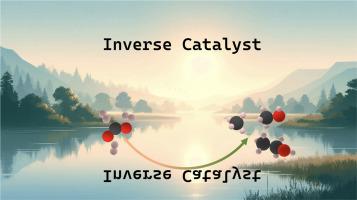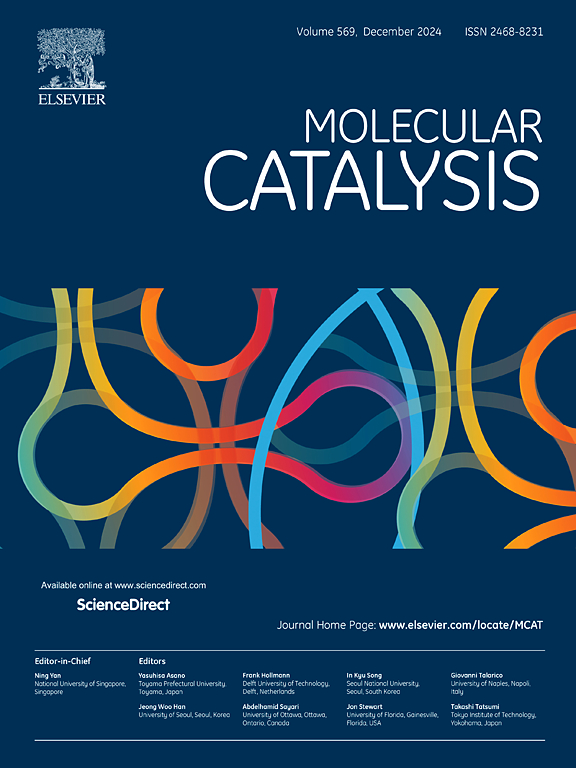用于增强二氧化碳加氢的反相支撑 Al2O3/Coº 催化剂
IF 3.9
2区 化学
Q2 CHEMISTRY, PHYSICAL
引用次数: 0
摘要
反相催化剂以其独特的界面为特征,在二氧化碳转化方面表现出卓越的催化活性。本研究通过调节氧化物前驱体中 Co/Al 的比例,还原高 Co 含量的 Co-Al 氧化物,探索合成 Al-Co 氧化物/Co0 反相催化剂。生成的反相催化剂可显著提高二氧化碳加氢,增加甲烷、甲醇和乙醇的产量,其中乙醇的产量明显增加。其中,Co/Al 比为 9:1 的催化剂实现了甲烷(32131 μmol/g)、甲醇(461 μmol/g)和乙醇(123 μmol/g)的高产率。为了阐明其结构和反应机理,还使用一系列技术对反相催化剂进行了表征。据推测,反相催化剂上大量的活性位点加上其适度的 H 结合亲和力,促进了 CO2 的活化和转化。这一点在*HCOO 和*CH3 中间产物的耦合增强方面尤为明显,从而促进了乙醇的合成。这项研究不仅揭示了用于 CO2 加氢的 Co 基催化剂中金属与金属氧化物之间的相互作用,还提出了为此类工艺制作高效催化剂的简便方法。本文章由计算机程序翻译,如有差异,请以英文原文为准。

Inverse supported Al2O3/Coº catalysts for enhanced CO2 hydrogenation
Inverse catalysts, characterized by their distinctive interfaces, demonstrate exceptional catalytic activity for CO2 conversion. This study explores the synthesis of an Al-Co oxide/Co0 inverse catalyst through the reduction of a Co-Al oxide with a high Co content, achieved by modulating the Co/Al ratio in the oxide precursor. The resulting inverse catalyst significantly enhances CO2 hydrogenation, yielding increased production of methane, methanol, and ethanol, with a notable amplification in ethanol output. Amongst, the catalyst with a Co/Al ratio of 9:1 achieves high yields for methane (32,131 μmol/g, methanol (461 μmol/g), and ethanol (123 μmol/g). To elucidate the structure and reaction mechanism, the inverse catalyst was also characterized using a suite of techniques. It is posited that the abundance of active sites on the inverse catalyst, coupled with its moderate H binding affinity, facilitates CO2 activation and conversion. This is particularly evident in the enhanced coupling of *HCOO and *CH3 intermediates, which promotes ethanol synthesis. This research not only sheds light on the interactions between metal and metal oxide within Co-based catalysts for CO2 hydrogenation but also proposes a facile method for crafting efficient catalysts for such processes.
求助全文
通过发布文献求助,成功后即可免费获取论文全文。
去求助
来源期刊

Molecular Catalysis
Chemical Engineering-Process Chemistry and Technology
CiteScore
6.90
自引率
10.90%
发文量
700
审稿时长
40 days
期刊介绍:
Molecular Catalysis publishes full papers that are original, rigorous, and scholarly contributions examining the molecular and atomic aspects of catalytic activation and reaction mechanisms. The fields covered are:
Heterogeneous catalysis including immobilized molecular catalysts
Homogeneous catalysis including organocatalysis, organometallic catalysis and biocatalysis
Photo- and electrochemistry
Theoretical aspects of catalysis analyzed by computational methods
 求助内容:
求助内容: 应助结果提醒方式:
应助结果提醒方式:


